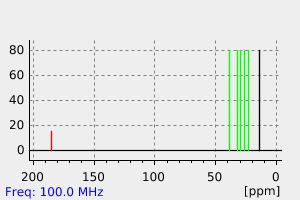庚酸酯 | 7563-37-3
中文名称
庚酸酯
中文别名
O-(2-氨基乙基)-L-丝氨酸
英文名称
heptanoate
英文别名
heptanoic acid; deprotonated form;Heptanoat
CAS
7563-37-3
化学式
C7H13O2
mdl
——
分子量
129.179
InChiKey
MNWFXJYAOYHMED-UHFFFAOYSA-M
BEILSTEIN
——
EINECS
——
-
物化性质
-
计算性质
-
ADMET
-
安全信息
-
SDS
-
制备方法与用途
-
上下游信息
-
文献信息
-
表征谱图
-
同类化合物
-
相关功能分类
-
相关结构分类
计算性质
-
辛醇/水分配系数(LogP):3.2
-
重原子数:9
-
可旋转键数:4
-
环数:0.0
-
sp3杂化的碳原子比例:0.86
-
拓扑面积:40.1
-
氢给体数:0
-
氢受体数:2
SDS
反应信息
-
作为反应物:描述:7-[2-(3-acetoxy-octyl)-4-oxo-thiazolidin-3-yl]-heptanoic acid methyl ester 、 庚酸酯 在 silica gel 作用下, 生成 7-[2-(3(S)-hydroxyoctyl)-4-oxo-3-thiazolidinyl]heptanoic acid参考文献:名称:Certain thiazolidine compounds摘要:本发明涉及新型8-aza-9-oxo-11-thia、-11-oxothia和-11-dioxothia-prostanoic酸化合物、盐和衍生物的制备方法。这些化合物具有类前列腺素的生物活性,特别适用于肾血管扩张剂、治疗某些自身免疫性疾病和预防血栓形成。公开号:US04059587A1
-
作为产物:描述:参考文献:名称:Lactones. 2. Enthalpies of hydrolysis, reduction, and formation of the C4-C13 monocyclic lactones. Strain energies and conformations摘要:The enthalpies of hydrolysis of the monocyclic lactones from gamma-butyrolactone to tridecanolactone were determined calorimetrically, and the acyclic ethyl esters having the same number of atoms were studied in the same fashion. The enthalpies of reduction of the lactones to the corresponding alpha,omega-alkanediols with lithium triethylborohydride also were determined. The enthalpies of formation of the lactones and the ethyl esters were derived from these data. They were converted to values for the gas phase by measuring the enthalpies of vaporization of ethyl esters and of lactones. In the cases of gamma-butyrolactone and delta-valerolactone, the enthalpies of formation were in good accord with the previously reported values determined via combustion calorimetry. The strain energies of the lactones were obtained via isodesmic reactions. Valerolactone had a strain energy of 11 kcal/mol, and the largest strain energy was found with octanolactone (13 kcal/mol). The conformations of gamma-butyrolactone and delta-valerolactone were studied via MP2/6-31G* geometry optimizations, and the conformations of the other lactones were studied with use of the molecular mechanics program MM3. The energies of the lactones estimated via molecular mechanics were compared with the experimental results.DOI:10.1021/ja00020a036
-
作为试剂:参考文献:名称:Process for preparing haloketo acid derivatives摘要:制备卤代酮酸衍生物的过程[I]:其中R是H或C.sub.1-6烷基,X是氯或溴,包括将β-氧代酸酯[II]与亚硝化试剂[IV]反应:其中R.sup.4是H,烷基,卤素或SO.sub.3 H,以得到7-卤代-2-羟基氨基庚酸酯[III],其中R.sup.1和X与上述相同,然后再将该产物与醛或酮反应;以及制备该中间体的过程。所述卤代酮酸衍生物可用作合成西司他丁的中间体,西司他丁可用作药物,特别是作为脱氢肽酶抑制剂。公开号:US05268501A1
文献信息
-
CYCLODEXTRIN-CATALYZED HYDROLYSIS OF ESTERS BEARING A HYDROPHOBIC TAIL作者:Akihiko Ueno、Iwao Suzuki、Yoshihiro Hino、Atsuko Suzuki、Tetsuo OsaDOI:10.1246/cl.1985.159日期:1985.2.5γ-Cyclodextrin-catalyzed hydrolysis of p-nitrophenyl esters bearing a long alkyl chain proceeded with larger rate acceleration than those with a short alkyl chain. Such rate acceleration behavior was not observed with β-cyclodextrin. The results suggest that the esters with a long alkyl chain take a folded structure (Type A) in the γ-cyclodextrin cavity.
-
Substituted 3-amino chromans申请人:The Upjohn Company公开号:US05306830A1公开(公告)日:1994-04-26The present invention is directed to novel chromane derivatives substituted in the 3-position by a substituted amino moiety and substituted on the aromatic ring with one or two substituents. The novel chromane derivatives have useful CNS properties. ##STR1##
-
Jasmonates meet fatty acids: functional analysis of a new acyl-coenzyme A synthetase family from Arabidopsis thaliana作者:Lucie Kienow、Katja Schneider、Michael Bartsch、Hans-Peter Stuible、Hua Weng、Otto Miersch、Claus Wasternack、Erich KombrinkDOI:10.1093/jxb/erm325日期:2008.2Arabidopsis thaliana contains a large number of genes encoding carboxylic acid-activating enzymes, including long-chain fatty acyl-CoA synthetase (LACS), 4-coumarate:CoA ligases (4CL), and proteins closely related to 4CLs with unknown activities. The function of these 4CL-like proteins was systematically explored by applying an extensive substrate screen, and it was uncovered that activation of fatty acids is the common feature of all active members of this protein family, thereby defining a new group of fatty acyl-CoA synthetase, which is distinct from the known LACS family. Significantly, four family members also displayed activity towards different biosynthetic precursors of jasmonic acid (JA), including 12-oxo-phytodienoic acid (OPDA), dinor-OPDA, 3-oxo-2(2′-[Z]-pentenyl)cyclopentane-1-octanoic acid (OPC-8), and OPC-6. Detailed analysis of in vitro properties uncovered significant differences in substrate specificity for individual enzymes, but only one protein (At1g20510) showed OPC-8:CoA ligase activity. Its in vivo function was analysed by transcript and jasmonate profiling of Arabidopsis insertion mutants for the gene. OPC-8:CoA ligase expression was activated in response to wounding or infection in the wild type but was undetectable in the mutants, which also exhibited OPC-8 accumulation and reduced levels of JA. In addition, the developmental, tissue- and cell-type specific expression pattern of the gene, and regulatory properties of its promoter were monitored by analysing promoter::GUS reporter lines. Collectively, the results demonstrate that OPC-8:CoA ligase catalyses an essential step in JA biosynthesis by initiating the β-oxidative chain shortening of the carboxylic acid side chain of its precursors, and, in accordance with this function, the protein is localized in peroxisomes.拟南芥含有大量编码羧酸活化酶的基因,包括长链脂肪酰基-CoA 合成酶(LACS)、4-香豆酸:CoA 连接酶(4CL)以及与 4CL 密切相关但活性未知的蛋白。通过广泛的底物筛选,系统地探索了这些 4CL 类蛋白质的功能,发现脂肪酸的活化是该蛋白家族所有活性成员的共同特征,从而定义了一组新的脂肪酰基-CoA 合成酶,与已知的 LACS 家族不同。值得注意的是,四个家族成员还对茉莉酸(JA)的不同生物合成前体表现出活性,包括 12-氧代-2-(2′-[Z]-戊烯基)环戊烷-1-辛酸(OPC-8)和 OPC-6。对体外特性的详细分析发现,各酶的底物特异性存在显著差异,但只有一种蛋白质(At1g20510)显示出 OPC-8:CoA 连接酶活性。通过对拟南芥基因插入突变体进行转录本和茉莉酸酯分析,分析了其体内功能。在野生型中,OPC-8:CoA 连接酶的表达在受伤或感染时被激活,但在突变体中却检测不到,突变体也表现出 OPC-8 的积累和 JA 水平的降低。此外,还通过分析启动子::GUS 报告基因系监测了该基因的发育、组织和细胞类型特异性表达模式及其启动子的调控特性。总之,研究结果表明,OPC-8:CoA 连接酶通过启动其前体羧酸侧链的 β-氧化链缩短作用,催化了 JA 生物合成过程中的一个重要步骤。
-
Identification of Key Residues for Enzymatic Carboxylate Reduction作者:Holly Stolterfoht、Georg Steinkellner、Daniel Schwendenwein、Tea Pavkov-Keller、Karl Gruber、Margit WinklerDOI:10.3389/fmicb.2018.00250日期:——Little is known about the structure of CARs and their catalytically important amino acid residues. The identification of key residues for carboxylate reduction provides a starting point to gain deeper understanding of enzymatic carboxylate reduction. A multiple sequence alignment of CARs with confirmed activity recently identified in our lab and from the literature revealed a fingerprint of conserved羧酸还原酶(CARs,EC 1.2.1.30)从其相应的羧酸中以高选择性生成醛。关于CAR的结构及其催化重要的氨基酸残基知之甚少。鉴定用于羧酸盐还原的关键残基为深入了解酶促羧酸盐还原提供了一个起点。最近在我们的实验室中从文献中鉴定出具有确定活性的CAR的多序列比对,揭示了保守氨基酸的指纹。我们通过这些残基的多个序列比对和突变替换研究了保守残基的功能。在这项研究中,研究了Neurospora crassa CAR的单部位丙氨酸变体,以确定保守残基对功能的贡献,酶的表达性或稳定性。通过在体内和体外分析变体的酶活性来研究氨基酸置换的作用。在分子建模的支持下,我们解释了这些残基中的五个对于催化活性或底物和共底物结合至关重要。我们鉴定出对CAR活性具有显着影响的氨基酸残基。用Ala替代His 237,Glu 433,Ser 595,Tyr 844和Lys 848废除了CAR活性,表明它们在减少酸中的
-
Contrasting behaviors of the cleavage of aryl alkanoates by .alpha.- and .beta.-cyclodextrins in basic aqueous solution作者:Oswald S. Tee、Xian Xian DuDOI:10.1021/jo00243a055日期:1988.4
表征谱图
-
氢谱1HNMR
-
质谱MS
-
碳谱13CNMR
-
红外IR
-
拉曼Raman
-
峰位数据
-
峰位匹配
-
表征信息
同类化合物
(±)17,18-二HETE
(±)-辛酰肉碱氯化物
(Z)-5-辛烯甲酯
(Z)-4-辛烯酸
(R)-甲羟戊酸锂盐
(R)-普鲁前列素,游离酸
(R,R)-半乳糖苷
(E)-4-庚烯酸
(E)-4-壬烯酸
(E)-4-十一烯酸
(9Z,12E)-十八烷二烯酸甲酯
(6E)-8-甲基--6-壬烯酸甲基酯-d3
(3R,6S)-rel-8-[2-(3-呋喃基)-1,3-二氧戊环-2-基]-3-羟基-2,6-二甲基-4-辛酮
龙胆二糖
黑曲霉二糖
黄质霉素
麦芽酮糖一水合物
麦芽糖醇
麦芽糖酸
麦芽糖基蔗糖
麦芽糖一水合物
麦芽糖
鳄梨油酸乙酯
鲸蜡醇蓖麻油酸酯
鲸蜡醇油酸酯
鲸蜡硬脂醇硬脂酸酯
鲸蜡烯酸脂
鲸蜡基花生醇
鲫鱼酸
鲁比前列素
鲁比前列素
高级烷基C16-18-醇
高甲羟戊酸
高效氯氰菊酯
高-gamma-亚油酸
马来酸烯丙酯
马来酸氢异丙酯
马来酸氢异丁酯
马来酸氢丙酯
马来酸氢1-[2-(2-羟基乙氧基)乙基]酯
马来酸单乙酯
马来酸单丁酯
马来酸二辛酯
马来酸二癸酯
马来酸二甲酯
马来酸二烯丙酯
马来酸二正丙酯
马来酸二戊基酯
马来酸二异壬酯
马来酸二异丙酯







